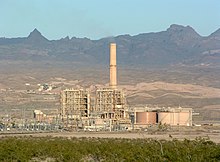Electricity generation

Electricity generation is the making of electricity for use by people. Most comes from rotary electrical generators turned by various engines.
History
[change | change source]Making electricity in one central place became useful when electric power distribution was possible. This required power transformers which could change voltage. Electricity could be sent as alternating current along electric power lines for great distances cheaply.
People have been using electric light bulbs, electric motors, and other things that use electricity since the late 19th century. Different sources of energy have been used to run generators, including coal, nuclear, natural gas, hydroelectric, and petroleum power and a small amount from solar energy, tidal harnesses, wind generators, and geothermal sources.

Electricity demand
[change | change source]The demand for electricity can be met in two different ways. The main method is to build large centralized projects to generate and transmit the electricity required. Many of these projects have caused unpleasant environmental effects such as air or radiation pollution and the flooding of large areas of land.
Distributed generation creates power on a smaller scale at locations on the electricity network. These sites often generate electricity as a byproduct of other industry such as using gas from landfills to power turbines.
Methods of generating electricity
[change | change source]Turbines
[change | change source]Rotating turbines attached to electrical generators produce most commercially available electricity. Turbines are driven by a fluid which acts as an intermediate energy carrier. The fluids typically used are:
- steam - Water is boiled by nuclear fission or the burning of fossil fuels (coal, natural gas, or petroleum). Some newer plants use the sun as the heat source: solar parabolic troughs and solar power towers concentrate sunlight to heat a heat transfer fluid, which is then used to produce steam.
- water - Turbine blades are acted upon by flowing water, produced by hydroelectric dams or tidal forces,
- wind - Most wind turbines generate electricity from naturally occurring wind. Solar updraft towers use wind that is artificially produced inside the chimney by heating it with sunlight.
- hot gases - Turbines are driven directly by gases produced by the combustion of natural gas or oil.
Combined cycle gas turbine plants are driven by both steam and gas. They generate power by burning natural gas in a gas turbine and use residual heat to generate additional electricity from steam. These plants offer efficiencies of up to 60%.
Reciprocating engines
[change | change source]Small electricity generators are often powered by reciprocating engines burning diesel fuel, biogas or natural gas. Diesel generators are often used for backup power, usually at low voltages. Biogas is often combusted where it is produced, such as a landfill or wastewater treatment plant, with a reciprocating engine or a microturbine, which is a small gas turbine.
Photovoltaic panels
[change | change source]Unlike the solar heat concentrators, photovoltaic panels convert sunlight directly to electricity. Although sunlight is free, solar panels cost a lot of money to make and have only a 10-20% conversion efficiency. Until recently, photovoltaics were most commonly used in remote sites where there is no access to a commercial power grid, or as an extra electricity source for individual homes and businesses. Recent advances in manufacturing efficiency and photovoltaic technology, combined with subsidies driven by environmental concerns, have dramatically accelerated the deployment of solar panels. Installed solar capacity is growing by 30% per year in several regions including Germany, Japan, California and New Jersey.